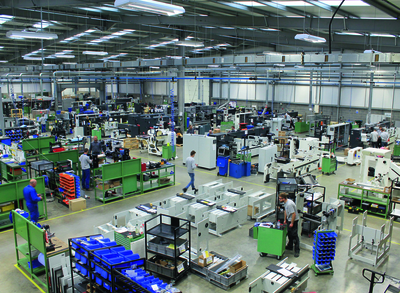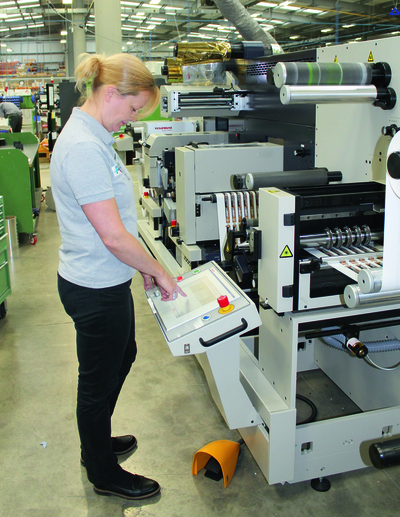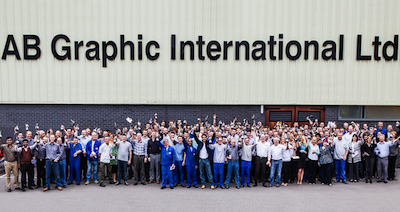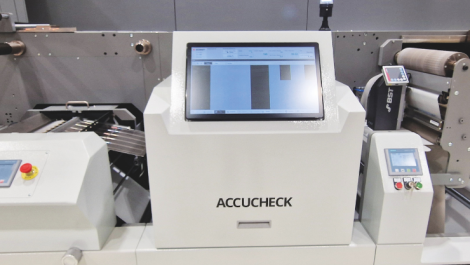Established in 1954 as The Burton Engineering Company, AB Graphic International celebrated its 60th anniversary last year. Despite having grown to a worldwide enterprise, the finishing equipment specialist is still very much a family-owned company with several generations of Burtons involved. Neel Madsen visited the Bridlington headquarters.
Headed up by managing director Mike Burton, whose grandfather founded the company, AB Graphic is Bridlington’s largest employer. It is housed in large purpose built premises on the Carnaby industrial estate, having moved here seven years ago when it outgrew its original home in town. With growth continuing, the plant has doubled in size since the move and today houses 160 employees spread over numerous departments including design, software development, R&D, service and customer care, as well as manufacturing.
Matt Burton, sales executive and fourth generation of the Burton family, said, ‘The global market is very strong and we are growing year on year. The key to our success is our employees and that we take a long term approach and make the right investments. Although we have aggressive expansion plans, it is important to do things sensibly.’
Global reach
The original Burton Engineering Company was established in 1954 by George H Burton. In its early years, the company’s focus was on producing a range of tag and ticket converting lines within the paper converting industry, including stringing machines for tags – a niche business that it continues today. In the late 1970s, AB Graphic Machinery was founded, originally as an importer of Japanese label machinery, but over the years growing its own manufacturing side to where it is today, having re-organised the two businesses.
With five international offices and some 50 plus distributors worldwide, this once small family business is today a world leader in finishing equipment for the label printing market and globally employs around 300 staff. There are three manufacturing plants, each dedicated to a specific product line to keep the focus. As well as Bridlington, which develops and manufactures the Digicon and Omega lines, there is a plant in Driffield, East Yorkshire, and one near Düsseldorf, in Germany.
The product range encompasses a multitude of machinery for the label converter and up to 90% is exported.
The Omega range of converting equipment is built on a modular platform and can be tailored to the customer’s exact specification – ranging from more basic machines for the blank label market to sophisticated combinations with rotary die-cutting, flexo units, inkjet units, laminating, hot and cold foil applications, and advanced 100% camera inspection systems. There are also Omegas for the production of booklet labels – a rapidly growing market.
Then there is the successful Vecra range of turret rewinders with over 1300 installations, which also can be specified for the customer’s exact needs, be it for converting stamps or self-adhesive labels. The company furthermore provides security solutions for RFID as well as EAS (Electronic Article Surveillance) insertion and inspection applications.
Going digital
For the conversion of digitally printed labels, ABG is no doubt the market leader with the total number of installations worldwide of its Digicon series of machines fast approaching 1000. It success in this sector is very much built on the fact that the company saw the potential of digital very early on and started working with what was then Indigo to provide a finishing solution for the Omnius press. This is a relationship that has continued with ABG most recently developing the Digicon 3000 for the HP Indigo 20000 together with press manufacturer Edale.
Labelexpo Americas this year saw the launch of the third generation of the Digicon, developed over the last two years to meet the growth in speed of digital presses and to run inline with all types, including newer inkjet machines from a variety of manufacturers. The company has already received orders from customers in France, Holland, Spain, US, UK and Japan, keen to take advantage of its quick set up and low waste.

The layout of the shop floor at ABG is based on ‘lean’ management principles
The series 3 machine is quite different from its predecessor. Most notably, a new web handling system has made the total length of the machine much shorter, and also enabled semi-rotary and full rotary processes to take place simultaneously. The machine also has higher running speeds of up to 150 m/min and significant improvements in cold foiling, hot foiling and screen printing speeds as well as providing an easier interface for operators. Its improved modularity means that it is faster to build as each part can be assembled and tested individually, and also that functionalities can be added more easily. This has been accomplished in part by a complete overhaul of the electrical wiring system, which is now an integral part of the machine, whereas on the series 2, a separate electrical unit stood behind the converting line taking up extra space. With floor space at a premium, this new design will no doubt be welcomed by converters.
Automation is king
Finishing is often referred to as a bottleneck where converting of digital labels and packaging is concerned, but with increased speeds and higher levels of automation, it is no longer a problem running the finishing machine inline with the press. Matt Burton commented, ‘Finishing certainly doesn’t have to be a bottleneck today. We have the technology that facilitates inline finishing of digitally printed labels. Indeed we have customers running inline at 50 m/min.’
One of these technologies is the new automated knife-slitting unit, which sets five knives in perfect position in just 45 seconds via either the touchscreen on the machine or by accessing the system remotely. As manual setting can take up to 10 minutes or more, this offers time savings of up to 3.5 hours per shift and means that the machine can be up and running much faster. Tony Bell, sales director, commented, ‘The amount of time the Auto Slit unit will save people is just unreal and the beauty is the knives can be set remotely via JDF. You don’t even have to be near the machine!’
One fast growing niche market is peel & reveal labels, and ABG is in the process of building the first series 3 machine to feature a crossover unit for the production of this type of labels. There are already many series 2 machines with peel & reveal units in operation at label printers who have spotted this opportunity to take advantage of incoming EU legislation that demands more information on packaging.
Lean manufacturing
The huge factory floor at the Bridlington plant runs like a well-oiled machine using lean management methods. Each department has a lean ‘champion’ who takes on the responsibility of monitoring quality control and identifying areas of the production process that can be improved. Weekly audits based on the 5s system are displayed on the notice board charting production and noting all factors that can influence why targets have not been met or have been exceeded. A traffic light system highlights the departments performing well and those that need to improve. As well as the lean champion in each department, two full time staff are in charge of the lean implementation throughout all areas of the business.

Anyone can programme the auto slitter, even editor Neel Madsen
On the factory floor stand a number of ‘Kanban’ stations, another lean method that aligns inventory levels with actual consumption to avoid downtime in production. Each assembly station has a ‘two bin’ system which means that all components needed for building the part in question are housed in two identical sets of bins (or boxes) that can be replenished on a continuous loop.
‘We have seen great results with lean management, but it has to be ingrained into the whole company. We have done that by empowering people and give them a chance to make a difference,’ said Matt Burton. ‘The Kanban system has greatly improved efficiency. No more stopping production due to missing parts and trips to the store room.’
Quality control team also monitors the different areas of production and KPIs (key performance indicators) are used to drive efficiency. These targets are also published on the notice boards in the factory so staff can see how they are performing and where there is room for improvement.
The company has made huge investments in high quality machinery. In the machine shop stands a row of fully automatic Hurco CNC milling machines busily cutting out frames, which are then finished and assembled further down the line. Several Bridgport manual mills are also still in operation for making one off or difficult items by hand. These machines are also used for training.
Investment in people
ABG’s location in Bridlington on the North Yorkshire coast, along with the general shortage of skilled engineers in the manufacturing industry, present a challenge for the company in terms of finding qualified staff. This is met by taking on a large number of new apprentices each year and training them up. Each apprentice starts out in the machine shop where they learn all the skills needed and experience how each machine component is made. There is then the opportunity to develop into other areas if the desire and drive are there. ‘We build people up and try to get the best out of them so they can reach their full potential. We give them the opportunity to succeed,’ said Matt Burton.
Involving staff in the running of the business and encouraging them to take responsibility is not a new concept at AB Graphic. In the boardroom hang several posters from the time of The Burton Engineering Company. One speaks about waste and starts, ‘Has it ever struck you that you have a personal stake in preventing waste? You have.’ It would seem that ‘lean’ is an integral part of the lifeblood of AB Graphic International and that its success is very much based on the faith the management places in the employees.






